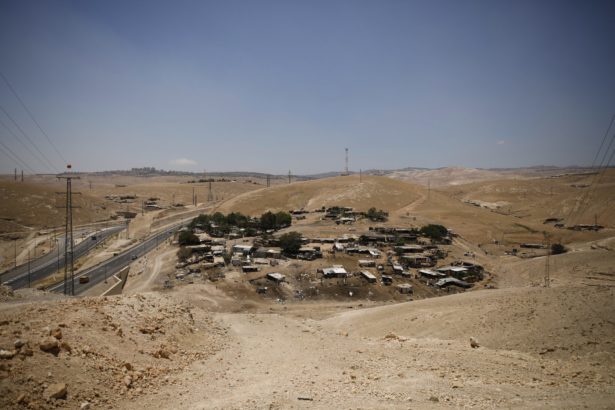Khan al-Ahmar is behind a highway that divides two bustling Israeli settlements. Credit: Corinna Kern for The New York Times
The bedouins in Khan al-Ahmar are considered an “existential threat” to the Jewish State; Israel plans to demolish the village and relocate the entire tribe to a location that denies the people their ancient culture. Israel’s Supreme Court has green-lighted the process, which will enable the state to cut the West Bank into pieces – although it may be a war crime.
By David M. Halbfinger and Rami Nazzal, reposted from the New York Times
KHAN AL-AHMAR, West Bank — The herders are being herded.
Any day now, the Israeli Army says, bulldozers will arrive to wipe the West Bank Bedouin community of Khan al-Ahmar off the map.
For decades, Israel has wanted to clear a large section of the West Bank of several thousand Bedouins — who raise sheep and goats in the creases of the hills east of Jerusalem — to make room for the expansion of Jewish settlements.
After an ugly televised eviction in the late 1990s, when soldiers hauled off families and bulldozers leveled a whole neighborhood, displaying the occupation’s brute force, liberal Israeli judges and foreign diplomats helped slow the expulsions. Nothing was stopped, but much was stalled — again and again.
The army issued scores of demolition orders for the Bedouins’ rickety hovels of corrugated tin, scrap wood and nylon fabric. Periodically, soldiers tore down a few shacks, toppled water tanks, carted off solar panels or staged military training exercises on the site, in what critics called a drip-drip campaign to make life so miserable that residents would simply leave. But the army did not dare demolish an entire village again.

Now, however, the brakes may be off. With the Trump administration providing diplomatic cover, right-wing ministers in Israel pressing to exploit that while it lasts and international support for the Palestinians focused for the moment on Gaza, a new ruling by a settler-majority panel of Israel’s Supreme Court appears to have freed the government to proceed with the removal of entire Bedouin communities on the West Bank. Advocates of the Bedouins say this would be a war crime: the forced transfer of a population under the protection of the military occupation.
“Everyone’s asking me, ‘What are you going to do, Bedouin?’” said Eid Abu Khamis, 51, Khan al-Ahmar’s leader. “I don’t have an F-16 or an F-15. I’m asking the international community: Where are the laws?”
Khan al-Ahmar is a dusty dot on the map, tucked behind a highway dividing two bustling Israeli settlements: Maale Adumim, so well-established as a suburb of Jerusalem that even leftists concede it would need to be carved out of a future Palestinian state; and a fast-growing offshoot, Kfar Adumim.
Bedouins have made the place their year-round home since at least the 1970s, though some, like Mr. Abu Khamis, say they were born there even earlier. Their tribe, the Jahalin, had wandered the Negev desert until being expelled by Israel after its establishment in 1948. When they arrived here in what was the uninhabited West Bank, the area was under Jordan’s control.

With Israel’s victory in the Six-Day War in 1967, the army took over, restricted the herders’ movements and expropriated the area as state land — without yet evicting the Bedouins. In the 1970s, the developers of Maale Adumim called for evacuating the Bedouins to build Jewish housing to the east and “cut off the Arab settlement continuity between Judea and Samaria,” the terms Israelis use to refer to the northern and southern halves of the West Bank.
With the start of the Oslo peace process in the 1990s, the Bedouins’ presence took on great geopolitical significance: If Israel were to develop the area, as the government has long threatened, it would bolster Maale Adumim’s contiguity with greater Jerusalem. But it would also effectively slice the West Bank into pieces, isolating Arab East Jerusalem and dividing Ramallah in the north from Bethlehem in the south — leaving a future Palestinian state to try to stitch itself together with tunnels or bridges through Israeli territory.

In effect, the Bedouins’ presence signals that the status quo is intact: As long as they are there, Israel must first clear them out before it can build, while the Palestinians can point to the Bedouins as place-holders for an eventual state.
To a first-time visitor, the village does not look like the contested linchpin of two dueling national destinies. It does not even look like much of a village. Without a jeep or a horse, visitors to Khan al-Ahmar pull over across Route 1, dodge speeding cars on foot, hurdle a metal barrier and climb a rocky hill. There are no electrical lines or water mains.
A few feet up is the open-air home of Faisal Abu Dayhok, 45, his wife, their six children and 16 ewes and rams that share a cramped corral the size of a two-car garage. A few feet farther is the school attended by the family’s four youngest children and about 150 other students from Khan al-Ahmar and several Bedouin villages nearby.
Built in 2009 by an Italian organization out of mud and used tires, both materials plentiful and cheap, the “tire school” made it safe for local children to walk to class, after several had been struck by cars commuting to schools in Jericho.
But settlers in Kfar Adumim and an advocacy group called Regavim perceived it as a threat, said Shlomo Lecker, the Bedouins’ longtime lawyer.
“It all started in a serious way after they built the school,” Mr. Lecker said of Regavim’s campaign to get the army to carry out the demolitions. “As long as the Bedouins live in these shacks, the right wing believes there will come a time, now or in some years, that they will find a way to kick the Bedouins out. The school was the only permanent thing in the area. So it became a symbol: If the school will be there, who knows what will be next?”

Regavim, borrowing the tactics that opponents like Peace Now have used against illegal Jewish outposts on the West Bank, pursued a simple argument in the courts: The law is the law.
No one disputed that the Bedouins’ buildings, including the school, had been erected without permits. But critics say that is the reasonable-sounding bottom line to a Kafkaesque deduction: For building permits to be granted, a village must have an approved master zoning plan, and Israel almost never approves Palestinian applications for either.
In the past, Israel’s Supreme Court tended to delay the day of reckoning for Bedouin communities, often by questioning whether the government was offering an adequate new home for the residents and their herds.
The Khan al-Ahmar Bedouins, for example, are to be moved to a cramped spot called Jahalin West, just outside Abu Dis — an urban setting, near an old garbage dump, with no room for their herds.

But in a decision on May 24, a three-judge panel — two of them current or former settlers, the Bedouins’ advocates noted — found that the Bedouins had been stalling, and that no reason existed to delay the demolitions further. What mattered was not the acceptability of the proposed alternative, the court ruled, but whether “the execution of the demolition orders meets legal requirements.”
Israel says Khan al-Ahmar is not only illegal but also unsafe, because of its proximity to Route 1, and the alternative — free plots with water and electrical hookups — will be a marked improvement. “The State of Israel will build a new, modern school at its own expense, which will be of significantly better quality than today’s structure,” said Assaf Zohar, a Defense Ministry spokesman.
Yet the new site offers only one-16th of an acre for each family — a fraction of what Bedouins from the tribe were granted in the late 1990s when they were displaced by the expansion of Maale Adumim. Oddly, the Supreme Court’s ruling claimed that there would be a place for their herds to graze — though the government had already acknowledged the opposite.
“They’re giving 250 square meters for each Bedouin,” Mr. Abu Khamis said of the land allotted each of Khan al-Ahmar’s 32 families. “Who is that for? Is it for the sheep? For the donkeys? For the dogs? For the humans?”

Some settlers have been stricken with remorse: A group of Kfar Adumim residents broke with those pushing for demolition and asked the court to require a negotiated settlement. One, Sallai Meridor, a former Israeli ambassador to the United States, wrote an anguished open letter to his neighbors.
“The Bedouin were here when we arrived,” Mr. Meridor wrote, saying that their presence had not blocked development of the settlement. “What has become of us that we now demand the poor man’s lamb for ourselves as well?”
Yet the government pressed on. Days after the ruling, approval was granted for a new 92-home neighborhood of Kfar Adumim a half-mile from Khan al-Ahmar.
Mr. Lecker said the government had claimed, without any basis, that the Bedouins would welcome life in an urban setting. But those who were moved to Jahalin West years ago say it has been impossible to sustain their way of life. “They’re trying to make us become less of the Bedouins we want to be,” said Muhammad Abu Khalil, 50. “The only things we have in our lives is raising our sheep.”
Some of his former neighbors have gone back to illegal homes in the hills, Mr. Abu Khalil said. Others would like to.
In Khan al-Ahmar, Mr. Abu Khamis says that the Israeli proposal has a fatal flaw: The Palestinian owners of record in Jahalin West — who do not recognize Israel’s confiscation of their property — have threatened to sue, in Palestinian court, to prevent the Khan al-Ahmar Bedouins from moving in.
All of which leaves Mr. Abu Khamis worrying that his neighbors will soon have no place to live.
“They kick you out from here, and then if we go there, it’s somebody else’s land,” he said. “In the U.S., they have people who work for NASA who go up to the moon. I’m hoping they can find someone who can make a planet for me.”
RELATED READING:
People of Khan Al-Ahmar mere pawns in cruel Israeli game
Another Palestinian village faces home demolitions: welcome to Abu Nuwar
Israeli Soldiers Demolish A Kindergarten And A Women’s Center Near Jerusalem
The plight and blight of home demolition in Israel and Palestine
Israel To Commit War Crime Against West Bank Villagers
For NYT, Israel Is Always Nearing ‘Apartheid,’ but Never Quite Gets There





